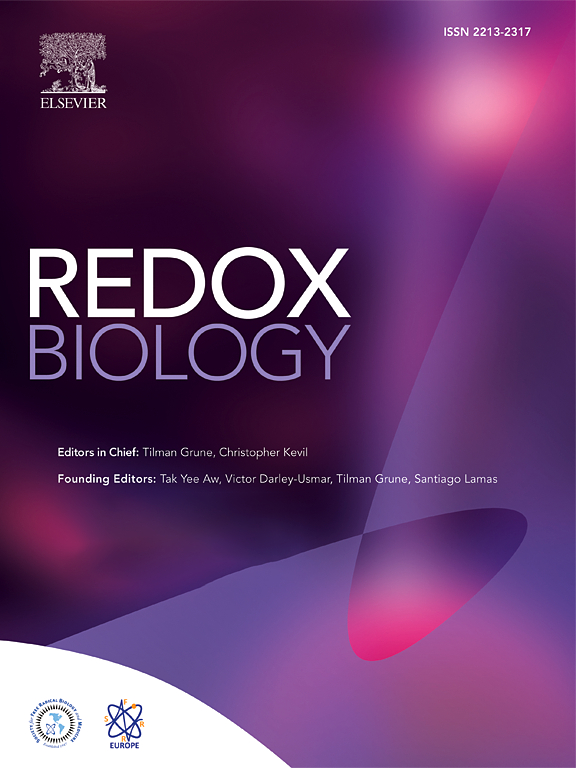Endothelial soluble epoxide hydrolase links polyunsaturated fatty acid metabolism to oxidative stress and atherosclerosis progression
IF 10.7
1区 生物学
Q1 BIOCHEMISTRY & MOLECULAR BIOLOGY
引用次数: 0
Abstract
Atheroslcerosis manifests as localized lesions within the vascular tree, preferentially affecting arteries at branch points, the outer wall of bifurcations and the inner walls of curvatures. Such spatial localized sensitivity to atherosclerosis, can be partially attributed to endothelial cell heterogeneity which compromises vascular fitness and contributes to the pathogenesis of the diseases. Here we identified that in a subcluster of aortic endothelial cells characterized with atheroprone gene signatures, the polyunsaturated fatty acids (PUFAs) metabolic enzyme soluble epoxide hydrolase (sEH) is selectively upregulated. Genetic endothelial-specific overexpression of the sEH resulted in excessive and accelerated atherosclerosis development, while inducible endothelial-specific deletion of sEH protected against PCSK9 mediated atherosclerotic plaque formation. Mechanistically, sEH-derived docosahexaenoic acid (DHA) diol (19,20-DHDP) disrupts mitochondrial protein-cholesterol associations in endothelial cells, which through reduced oxidizing metabolic import of pyruvate and malate inhibited mitochondrial Complex I activity. Such inhibition, resulted in a lowering of the mitochondrial membrane potential and subsequent excessive mitochondrial reactive oxygen species production and disrupted mitochondrial structure. Heightened mitochondrial redox generation ultimately led to TGFβ activation and the subsequent stimulation of an athroprone and pro-inflammatory endothelial transcriptional programme. Re-establishing redox homeostasis by antioxidant treatments, halted the atheroprone phenotypes of sEH overexpressing vessels. Our data propose that manipulating endothelial PUFA metabolism and sEH activity in the endothelium can exert vascular protective effects.

内皮可溶性环氧化物水解酶将多不饱和脂肪酸代谢与氧化应激和动脉粥样硬化进展联系起来
动脉粥样硬化表现为血管树内的局部病变,优先影响分支点的动脉、分叉的外壁和弯曲的内壁。这种对动脉粥样硬化的空间局部敏感性部分归因于内皮细胞的异质性,这种异质性损害了血管的适应性,并有助于疾病的发病机制。在这里,我们发现在以动脉粥样硬化基因特征为特征的主动脉内皮细胞亚群中,多不饱和脂肪酸(PUFAs)代谢酶可溶性环氧化物水解酶(sEH)选择性上调。遗传的内皮特异性sEH过表达导致动脉粥样硬化过度和加速发展,而诱导的内皮特异性sEH缺失可防止PCSK9介导的动脉粥样硬化斑块形成。在机制上,seh衍生的二十二碳六烯酸(DHA)二醇(19,20- dhdp)破坏内皮细胞中线粒体蛋白-胆固醇的关联,通过减少丙酮酸和苹果酸的氧化代谢进口抑制线粒体复合物I的活性。这种抑制导致线粒体膜电位降低,随后线粒体活性氧产生过多,线粒体结构被破坏。线粒体氧化还原生成的增加最终导致tgf - β活化,并随后刺激易致脂肪和促炎内皮细胞转录程序。通过抗氧化处理重建氧化还原稳态,阻止了sEH过表达血管的动脉粥样硬化表型。我们的数据表明,控制内皮细胞PUFA代谢和sEH活性可以发挥血管保护作用。
本文章由计算机程序翻译,如有差异,请以英文原文为准。
求助全文
约1分钟内获得全文
求助全文
来源期刊

Redox Biology
BIOCHEMISTRY & MOLECULAR BIOLOGY-
CiteScore
19.90
自引率
3.50%
发文量
318
审稿时长
25 days
期刊介绍:
Redox Biology is the official journal of the Society for Redox Biology and Medicine and the Society for Free Radical Research-Europe. It is also affiliated with the International Society for Free Radical Research (SFRRI). This journal serves as a platform for publishing pioneering research, innovative methods, and comprehensive review articles in the field of redox biology, encompassing both health and disease.
Redox Biology welcomes various forms of contributions, including research articles (short or full communications), methods, mini-reviews, and commentaries. Through its diverse range of published content, Redox Biology aims to foster advancements and insights in the understanding of redox biology and its implications.
 求助内容:
求助内容: 应助结果提醒方式:
应助结果提醒方式:


